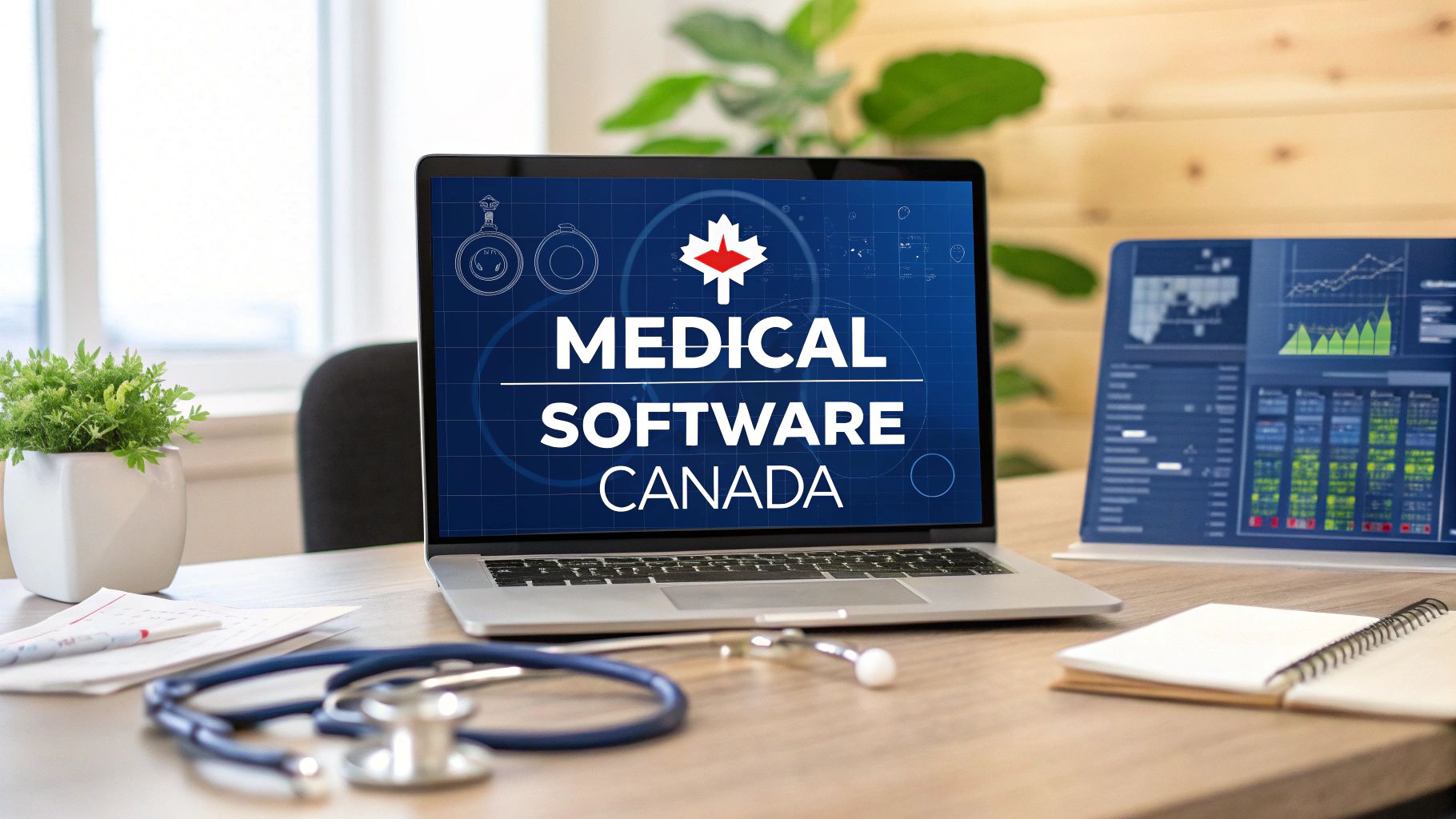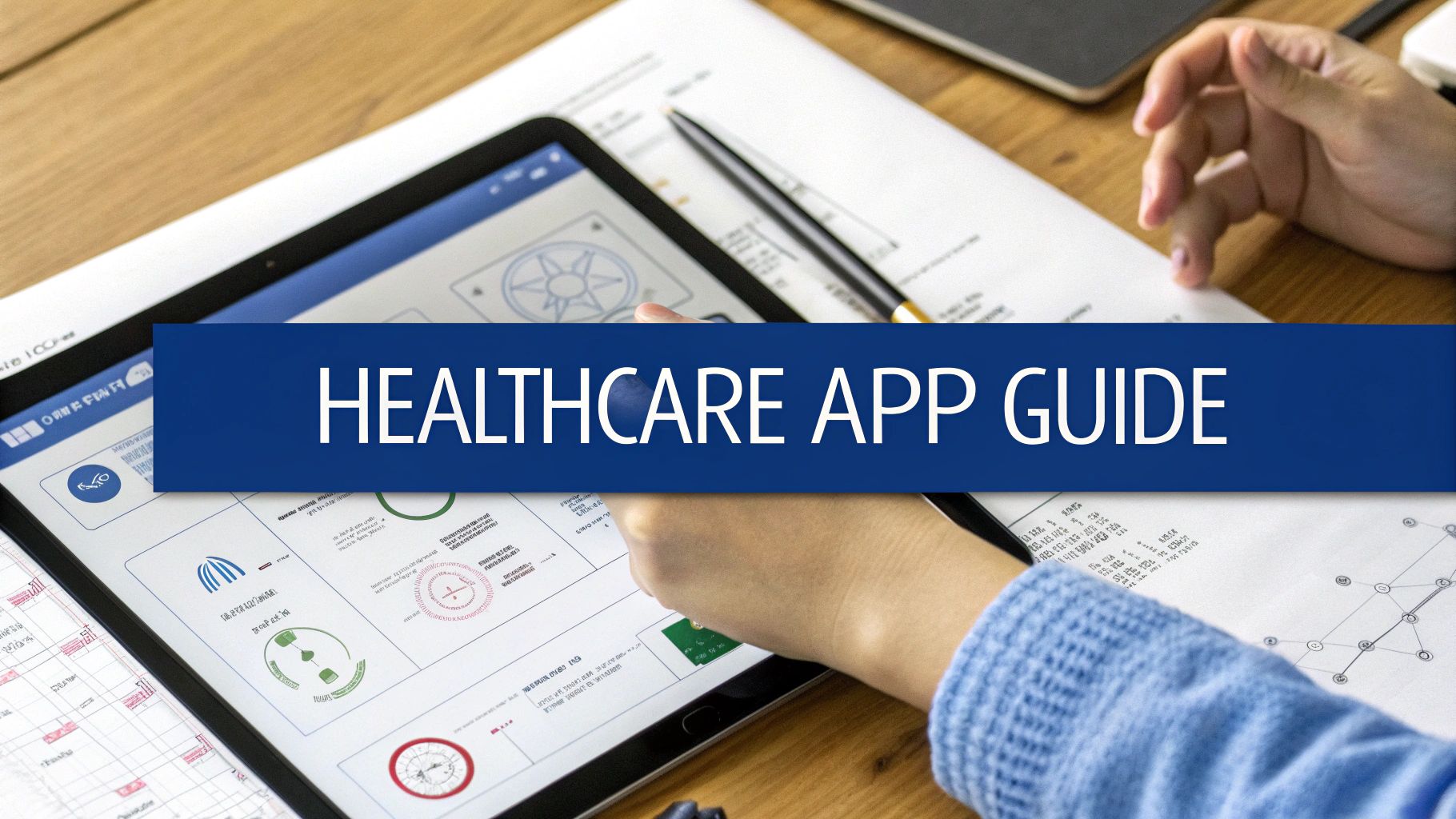Developing medical software in Canada is about more than just building apps. It’s a specialized field where cutting-edge technology meets the rigorous demands of our national and provincial healthcare regulations. At its core, it involves creating secure, effective, and reliable software that protects patient data under laws like the Personal Information Protection and Electronic Documents Act (PIPEDA).
Navigating Canada's Digital Health Frontier

Across the country, Canada's healthcare system is making a monumental shift. The old world of paper files and fax machines is slowly giving way to integrated digital solutions. While this opens up incredible opportunities for better patient care, it also creates a complex maze of challenges for anyone building new health technology.
Think about a typical clinic in downtown Vancouver, buried under mountains of patient charts. Appointments are booked by phone, and sharing a patient's history with a specialist is a logistical headache. This is the reality that modern medical software aims to solve. The journey from these manual, disconnected processes to a seamless digital ecosystem is what Canadian medical software development is all about.
The Path from Paper to Pixels
Consider this guide your roadmap for that journey. We'll break down the entire process, starting with the unique needs of the Canadian market and its notoriously strict regulatory environment. Here, building great software is about engineering trust.
We’re going to walk through everything you need to know:
-
Market Dynamics: We’ll look at what’s driving the demand for new healthtech, from government funding initiatives to the needs of our aging population.
-
Regulatory Compliance: I’ll demystify the roles of Health Canada, provincial health authorities, and privacy legislation like PIPEDA.
-
Development Lifecycle: You’ll get a step-by-step look at the process, from the first idea to post-launch support, all tailored to Canadian standards.
-
Technology Choices: We’ll discuss how to pick the right tech stack to build a platform that’s secure, scalable, and compliant from day one.
This digital shift is about so much more than convenience. It's about fundamentally rebuilding our healthcare infrastructure to improve patient outcomes, make our clinics and hospitals more efficient, and get ready for the medical breakthroughs of tomorrow.
New tools like artificial intelligence are becoming a big part of this picture. AI algorithms, for example, are already helping with diagnostics and personalizing treatment plans, which frees up clinicians to spend more time with their patients. We dive deeper into the specific benefits of AI in Canadian healthcare in another article.
By the time you finish this guide, you’ll have a clear, practical framework for creating successful medical software in this exciting and demanding market.
Understanding the Canadian Healthcare Software Market
Before you can build successful medical software in Canada, you need to get the lay of the land. The market here is accelerating, pushed forward by some major forces that are fundamentally changing healthcare across the country. Getting a handle on these dynamics is the first step toward creating something that clinicians and patients will actually want to use.
What’s driving all this change? A few key things. For one, provincial governments are putting serious weight behind digital health initiatives to connect what has long been a disjointed system. At the same time, Canada's aging population is ramping up the demand for healthcare that's more efficient, easier to access, and available remotely. This demographic shift is forcing the system to find smarter ways to work, and technology is the obvious answer.
Add to that the widespread move to cloud-based systems, which has torn down old barriers. Now, even small clinics can get their hands on powerful software that used to be the exclusive domain of large hospitals.
The Financial Scope of the Opportunity
The numbers tell a powerful story. In 2023, the Canadian healthcare information system market was already worth a massive USD 21.5 billion. But it's not stopping there. Forecasts predict it will more than double, hitting an estimated USD 48.5 billion by 2030. That’s a compound annual growth rate (CAGR) of 12.3%, which points to serious, long-term investment in healthtech. You can explore the full picture of Canada's healthcare information system market growth for a deeper dive.
This growth isn't spread evenly, though. In 2023, solutions for revenue cycle management took the biggest piece of the pie. This tells us something crucial: healthcare organizations are desperate to fix their financial and administrative headaches. While clinical tools are obviously essential, software that helps a practice or hospital stay financially healthy is in incredibly high demand.
Deconstructing the Market: Key Segments
Think of the Canadian healthcare software market like a busy hospital. It's made up of several distinct "departments" or segments, each with a specific job, but all needing to work together. Understanding these different areas helps you see where the real opportunities are.
Here’s a quick breakdown of the major players in this ecosystem:
Key Segments in the Canadian Healthcare Software Market
|
Software Segment |
Primary Function |
Market Status & Growth Driver |
|---|---|---|
|
Electronic Health Records (EHR) |
Centralizes patient data, medical history, and treatment plans into a single digital record. |
Foundational segment; growth is driven by interoperability demands and government incentives for data sharing. |
|
Telemedicine & Virtual Care |
Enables remote consultations, monitoring, and patient-doctor communication via video or messaging. |
Explosive growth post-pandemic; sustained by patient demand for convenience and improved access to specialists. |
|
Practice Management Software |
Manages the administrative side of a clinic, including scheduling, billing, and patient registration. |
Mature but evolving; opportunities exist in AI-powered automation and integration with EHR and billing systems. |
|
Medical Imaging & PACS |
Manages, stores, and allows viewing of medical images like X-rays, MRIs, and CT scans. |
Driven by advancements in AI for image analysis and the need for cloud-based storage and secure sharing. |
Each of these segments is a pillar holding up Canada's digital health strategy. Knowing how they operate is key to finding your niche.
The most powerful innovations often show up where these segments overlap. For example, a telemedicine platform that talks directly to a clinic's EHR and practice management software is a game-changer.
Getting to know these individual components and how they all click together is non-negotiable. Whether you’re building a specialized app for a niche medical field or a broad EHR system, a solid grasp of the market dynamics will help you position your medical software development in Canada for success. It’s about building not just what’s possible, but what’s genuinely needed.
Getting to Grips with Canadian Regulations and Compliance
Building medical software for the Canadian market is a bit like constructing a specialized hospital wing. You can't just throw up walls and call it a day; you need to follow a strict building code designed for patient safety. In Canada, this "code" is a robust set of regulations that are non-negotiable for anyone entering the health-tech space.
At the top, you have two main players. Health Canada acts as the federal overseer, making sure any medical device, including software, is safe and does what it claims to do. Then you have the privacy gatekeepers, led by the federal Personal Information Protection and Electronic Documents Act (PIPEDA), which protects sensitive patient data.
Think of it this way: Health Canada is the structural engineer ensuring your product won't cause harm, while PIPEDA is the security architect making sure the information inside is locked down tight.
Is Your Software a Medical Device?
First things first, you need to figure out if your software even counts as a medical device. This isn't always as clear-cut as it sounds. An app that tracks your daily steps for fun? Probably not a medical device. But an app that analyzes your smartwatch's heart rate data to flag potential arrhythmias? That almost certainly is.
It all comes down to the manufacturer's intended purpose. If you market your software for diagnosing, treating, or preventing a disease or condition, Health Canada will classify it as Software as a Medical Device (SaMD). Getting this classification right is the first major step in your regulatory journey.
Once your software is officially a SaMD, it gets sorted into one of four risk classes, from Class I (lowest risk) to Class IV (highest risk). This classification determines exactly how much scrutiny you'll face.
-
Class I: This is for low-risk software, like a simple program for archiving medical images. You'll need a Medical Device Establishment Licence (MDEL), but you can skip the detailed pre-market review.
-
Class II: We're moving into low-to-moderate risk here. Think of an app that helps patients manage their diabetes by tracking glucose levels. This requires a full Medical Device Licence application with solid proof of safety and effectiveness.
-
Class III: For moderate-to-high risk software, the review gets much more intense. A great example is an AI program that helps radiologists spot tumours on CT scans. You'll need to provide rigorous clinical and technical evidence.
-
Class IV: This is the highest-risk category, reserved for software that controls life-sustaining equipment like a pacemaker. As you can imagine, the approval process is incredibly stringent.
A good analogy is vehicle safety ratings. A simple bicycle (Class I) has very few required safety features, while a family minivan (Class II) has many more, and a Formula 1 car (Class IV) is regulated to an extreme degree based on the potential risk.
Protecting Patient Data with PIPEDA
While Health Canada is focused on the device itself, PIPEDA is all about the data. Specifically, it governs how you handle Personal Health Information (PHI), which is some of the most sensitive data out there. PIPEDA is founded on ten fair information principles, but the one you really need to nail is meaningful consent.
This means you can't just bury permission slips in a wall of legal text. For example, if your app wants to use anonymized patient data for a research study, you must get explicit, separate consent just for that. Your users have to know exactly what they’re agreeing to, why you’re collecting their information, and how you plan to use it. This is a foundational piece for any successful healthcare app development in Canada.
The Global Seal of Approval: ISO 13485
Staying compliant in Canada isn't just about following local rules. Embracing international standards is a powerful way to show you're serious about quality. The big one here is ISO 13485, the global standard for a Quality Management System (QMS) in the medical device world.
Achieving ISO 13485 certification tells Health Canada, and your customers, that you have solid, repeatable processes for everything from design and development to long-term support. It's the gold standard. On top of general quality, the unique digital threats in healthcare mean you should also consider bringing in experts who provide industry-specific security solutions for healthcare.
This complex regulatory environment is also steering the market. Canada’s healthcare software as a service (SaaS) market, for instance, is growing rapidly as providers move to the cloud. They're drawn to the cost savings and robust security offered by SaaS platforms that are already compliant with privacy laws like PIPEDA. The data on Canada's booming healthcare SaaS market clearly shows just how significant this shift has become.
Your Medical Software Development Lifecycle in Canada
Building medical software for the Canadian market isn't just a technical challenge; it’s a meticulously planned journey through a unique regulatory and clinical landscape. Each step has specific Canadian checkpoints that are critical for success. Think of the Software Development Lifecycle (SDLC) as your roadmap, it breaks down the immense task of creating a medical application into a series of manageable, sequential phases.
This structured approach is non-negotiable in a regulated environment like ours. It ensures quality, safety, and compliance are woven into the fabric of your software from day one, not just tacked on as an afterthought. For any team working on medical software development in Canada, getting this lifecycle right is fundamental.
Phase 1: Initial Requirements and Discovery
This first phase is all about listening. Before a single line of code gets written, you need a deep, nuanced understanding of the problem you're aiming to solve within the Canadian healthcare system. This means getting out there and talking to the people on the ground, Canadian clinicians, hospital administrators, and even patients, to gather precise requirements.
What makes this stage uniquely Canadian? A few key things come to mind:
-
Provincial Variations: You have to account for the patchwork of clinical workflows and reimbursement models that differ dramatically from British Columbia to Newfoundland.
-
Bilingual Needs: Federal law and user expectations often mandate full functionality in both English and French. This isn't just a translation task; it has to be planned from the very beginning.
-
Interoperability: A crucial, early-stage question is how your software will plug into existing provincial health record systems or hospital information systems.
Phase 2: Design and Prototyping
With a solid set of requirements in hand, you can start shaping the solution. The design phase is where you translate complex clinical needs into a user-friendly and accessible interface. In Canada, that means designing for a diverse population and adhering to accessibility standards like the Accessibility for Ontarians with Disabilities Act (AODA) where it applies.
This stage is never a one-and-done deal. It’s an iterative loop of creating wireframes and interactive prototypes, then putting them in front of the same clinicians you consulted earlier. Their feedback is gold, helping you refine the user experience until the final product feels intuitive for busy healthcare professionals. It's also where you lay the architectural groundwork for secure data handling, a cornerstone of mastering healthcare data management.

As this workflow shows, compliance isn't a final hurdle to clear; it’s a foundational process. Classification, compliance checks, and certification are sequential steps that must be built into the development plan from the start.
Phase 3: Development and Implementation
Now, the real build begins. Whether your team uses an agile methodology or a more traditional waterfall model, this is where the approved designs become a functional product. Developers write the code, set up the databases, and integrate any necessary third-party services.
Throughout this phase, maintaining a secure development environment is absolutely critical. Developers need to be trained in best practices to prevent vulnerabilities that could expose Personal Health Information (PHI), ensuring every line of code aligns with PIPEDA's privacy principles.
Phase 4: Rigorous Testing and Validation
Before your software ever sees a live clinical environment, it must survive a trial by fire. This goes far beyond typical bug hunting. For medical software in Canada, testing is a multi-faceted effort:
-
Security Testing: We're talking about penetration testing and vulnerability scans to make sure the application can stand up to cyber threats.
-
Compliance Validation: You have to systematically verify that all PIPEDA requirements, like consent management and data access controls, are properly implemented and work as intended.
-
Usability Testing: Real-world users test the software in simulated clinical scenarios to confirm it’s efficient and meets their needs without causing confusion or errors.
-
Performance Testing: The system is put under heavy load to ensure it remains stable and responsive, even when thousands of users are accessing it simultaneously.
For any software classified as a medical device by Health Canada, this phase demands formal validation. This is a documented process of proving, with objective evidence, that the software consistently meets its predefined specifications and quality attributes.
Phase 5: Deployment and Post-Launch Maintenance
Once your software has passed every test and validation check, it’s ready for deployment. This might start with a phased rollout to a pilot group of clinics or go straight to a full launch. But crossing the "go-live" finish line is just the beginning.
The lifecycle continues with continuous monitoring to catch any issues that pop up in the real world. Maintenance is an ongoing commitment, involving regular updates to patch security vulnerabilities, add new features requested by users, and keep the software compliant as regulations evolve. Each of these updates must follow a mini-version of this same lifecycle, ensuring quality and safety remain the top priority for the long haul.
Choosing Your Technology Stack and Architecture

Choosing the right technology for your medical software is a lot like an architect selecting the materials for a new hospital. Your foundation has to be unshakable, the framework must be secure, and every single component needs to work in perfect harmony to handle life-or-death functions. The decisions you make at this stage will dictate everything, your software's performance, its ability to grow, and its capacity to meet Canada's strict compliance standards.
This isn't just about picking the trendiest programming language. It's a strategic process that demands a careful balance between technical prowess and the real-world demands of our healthcare system. Get the technology stack right, and you're building a tool that's not just functional today but resilient enough for the future.
The Core Layers of a Healthtech Stack
Think of your technology stack as having three distinct layers, each playing a crucial part.
-
Frontend (The User Interface): This is the part of the software that clinicians, lab techs, and patients will actually see and touch. Frameworks like React, Angular, or Vue.js are the go-to choices here. They're excellent for building intuitive, responsive interfaces that feel natural on a desktop in a clinic or on a smartphone at home.
-
Backend (The Engine Room): The backend is where all the heavy lifting happens. It’s the server-side logic that manages data processing, enforces security protocols, and executes all the business rules. Languages like Python, Java, and Node.js are staples in healthtech because they're reliable, secure, and backed by massive libraries that can speed up development.
-
Database (The Secure Vault): This is where sensitive patient information lives. Security is paramount. Relational databases like PostgreSQL or MySQL are common for their structured nature, while NoSQL options like MongoDB offer more flexibility. The non-negotiable feature for any choice is robust, end-to-end encryption and strict access controls.
Monolithic vs. Microservices Architecture
Beyond the individual technologies, you have to decide on your system's fundamental blueprint: its architecture. This is a foundational choice that will shape how your software scales and adapts over time. The two main paths are monolithic and microservices.
A monolithic architecture is like building a single, all-in-one hospital. Every function, from patient scheduling to billing and electronic records, is tightly woven into one large application. This approach can be simpler to get off the ground, but it becomes a real headache to update or scale as the system gets bigger. A change in one area can have unintended consequences elsewhere.
On the other hand, a microservices architecture is more like building a campus of specialized, independent clinics. Each function exists as its own small service that communicates with the others. While it’s more complex to set up initially, this model provides incredible flexibility. You can update the telemedicine service without ever touching the billing system, making maintenance and scaling far more manageable.
When you're making these big-picture decisions, leaning on established principles can make all the difference. To build a truly robust and scalable system, it's worth learning more about essential software architecture design patterns to guide your choices.
Technology Stack Comparison for Medical Software
Picking the right tools is critical. This table breaks down some popular options and what you need to consider from a Canadian healthcare perspective.
|
Technology Layer |
Popular Options |
Key Considerations for Canadian Healthcare |
|---|---|---|
|
Frontend |
React, Angular, Vue.js |
Accessibility (WCAG) is key. The interface must be usable for all, including those with disabilities. Fast load times are crucial for clinical efficiency. |
|
Backend |
Node.js, Python (Django/Flask), Java (Spring) |
Needs strong security libraries for PHI protection. Performance must be reliable under heavy load. Must support interoperability standards like HL7 and FHIR. |
|
Database |
PostgreSQL, MySQL, MongoDB, Microsoft SQL Server |
Encryption at rest and in transit is non-negotiable. Requires detailed audit trails and access logs for PIPEDA compliance. Must support robust backup and disaster recovery. |
|
Cloud/Hosting |
AWS Canada, Microsoft Azure Canada, Google Cloud Canada |
Data Sovereignty: Must have data centres within Canada to comply with provincial data residency laws. Look for providers offering BAAs (Business Associate Agreements). |
|
Containerization |
Docker, Kubernetes |
Helps ensure consistent deployment environments, which is vital for validation and compliance. Kubernetes can manage scalable, resilient microservices. |
Ultimately, your technology choices should align directly with your software's specific goals, whether it’s a patient portal or a complex hospital management system.
The Cloud and Data Sovereignty in Canada
For any team building medical software in Canada, the cloud is the central piece of the puzzle. But you can't just use any cloud provider. Using a provider with data centres physically located within Canada is often a requirement for compliance.
Provincial data residency laws and federal regulations like PIPEDA strongly favour keeping Protected Health Information (PHI) within our borders. Hosting on Canadian soil is the simplest way to ensure data sovereignty, meaning all that sensitive information is governed by Canadian law. This isn't just a technicality; it's fundamental to earning the trust of healthcare providers and patients. The scale here is massive, as of early 2024, the Canadian hospital Electronic Health Records (EHR) market was already supporting around 175,000 active users across the country.
Frequently Asked Questions About Medical Software Development in Canada
When you're diving into medical software development in Canada, you're bound to run into some very specific, practical questions. Getting solid answers is key to mapping out your project's timeline, budget, and compliance path. Let's tackle some of the most common hurdles that developers and health innovators face.
These aren't just high-level theories; they're the real-world issues that can make or break a project. Nailing down these details from the start helps you sidestep expensive delays and ensure your software is ready for the Canadian healthcare system.
How Long Does Health Canada Approval Take for Medical Software?
There’s no single answer here. The timeline for getting Health Canada's green light hinges entirely on your software's risk classification. For a Class I device, which is the lowest risk category, the process can be quite fast. Since it doesn’t need a deep pre-market review, you could be looking at just a few weeks.
But as the risk level goes up, so does the waiting time.
-
Class II Devices: Approval for these medium-risk devices can stretch out over several months.
-
Class III & IV Devices: For high-risk software, be prepared to wait more than a year. These applications demand a painstaking review of clinical evidence and quality management systems.
The best way to speed things up? Submit a complete, perfectly organised application. Making sure every piece of documentation, especially your ISO 13485 certification, is buttoned up is absolutely critical to avoid getting stuck in a queue.
What’s the Real Difference Between PIPEDA and HIPAA?
At first glance, Canada's PIPEDA and America's HIPAA both seem to be about protecting health information, but they go about it in fundamentally different ways. HIPAA is a US-only law laser-focused on the healthcare sector. PIPEDA, on the other hand, is a broader Canadian law that covers how all commercial businesses handle personal information.
For a developer, the biggest takeaway is this: PIPEDA is consent-based. Your software absolutely must have clear, straightforward features for getting and managing a user's informed consent before you collect, use, or share their data. HIPAA is more prescriptive, laying out a specific set of rules for privacy and security that organizations must follow.
Do I Have to Host Medical Software Data Inside Canada?
While PIPEDA itself doesn't lock your data to Canadian soil, many provinces do. British Columbia and Nova Scotia, for example, have "data residency" laws. These rules insist that public sector data, and that includes a lot of health information, must be stored and accessed only from within Canada.
Because of this, it's become a standard best practice to use cloud providers that have data centres right here in Canada. It just makes life easier. This approach not only simplifies compliance but also minimizes the risks that come with sending data across borders, which goes a long way in building trust with Canadian healthcare providers and patients.
At Cleffex, our expertise is in turning these complex requirements into secure, compliant, and user-friendly medical software. If you're ready to bring your Canadian healthtech vision to life, see what we can do for you at https://www.cleffex.com.








